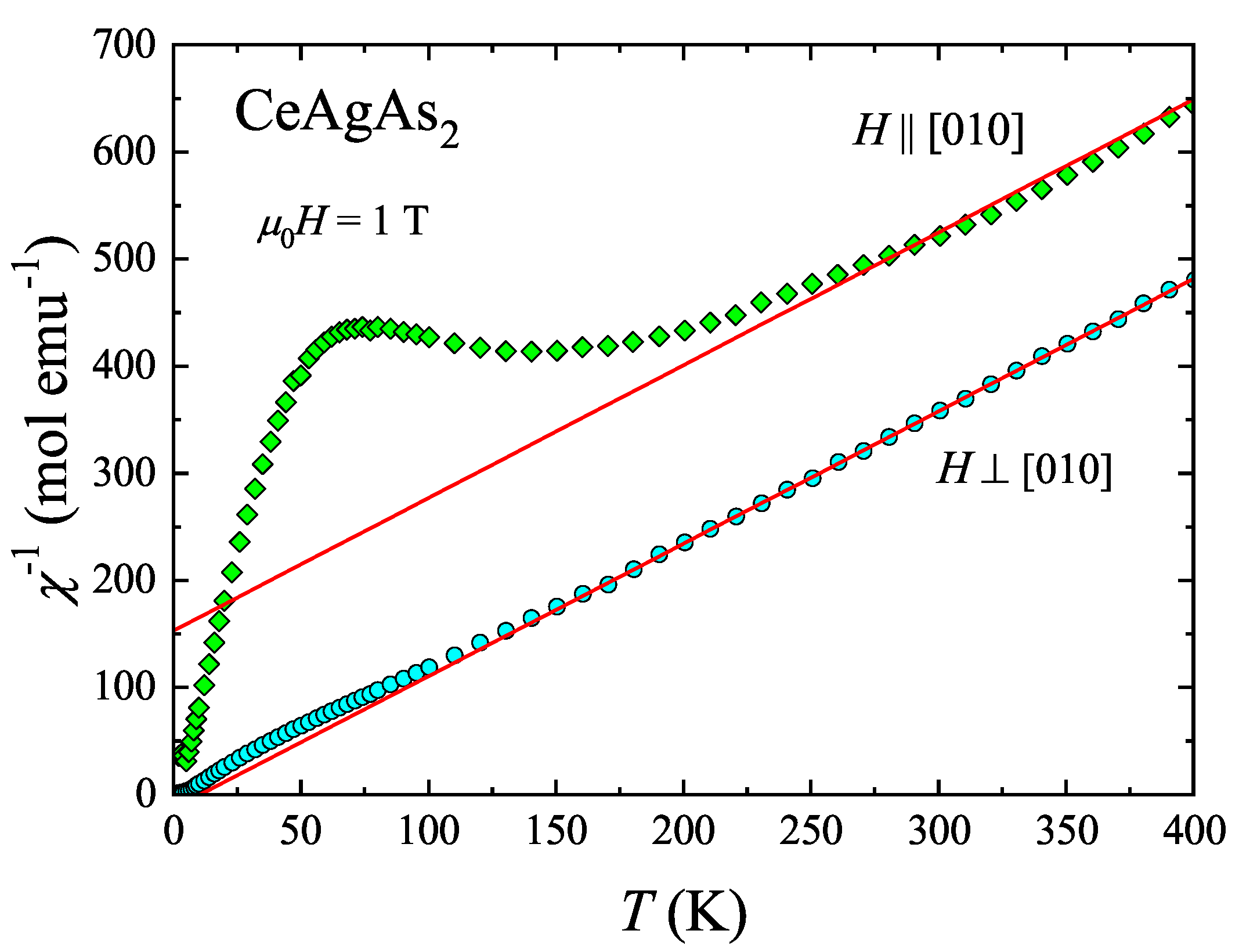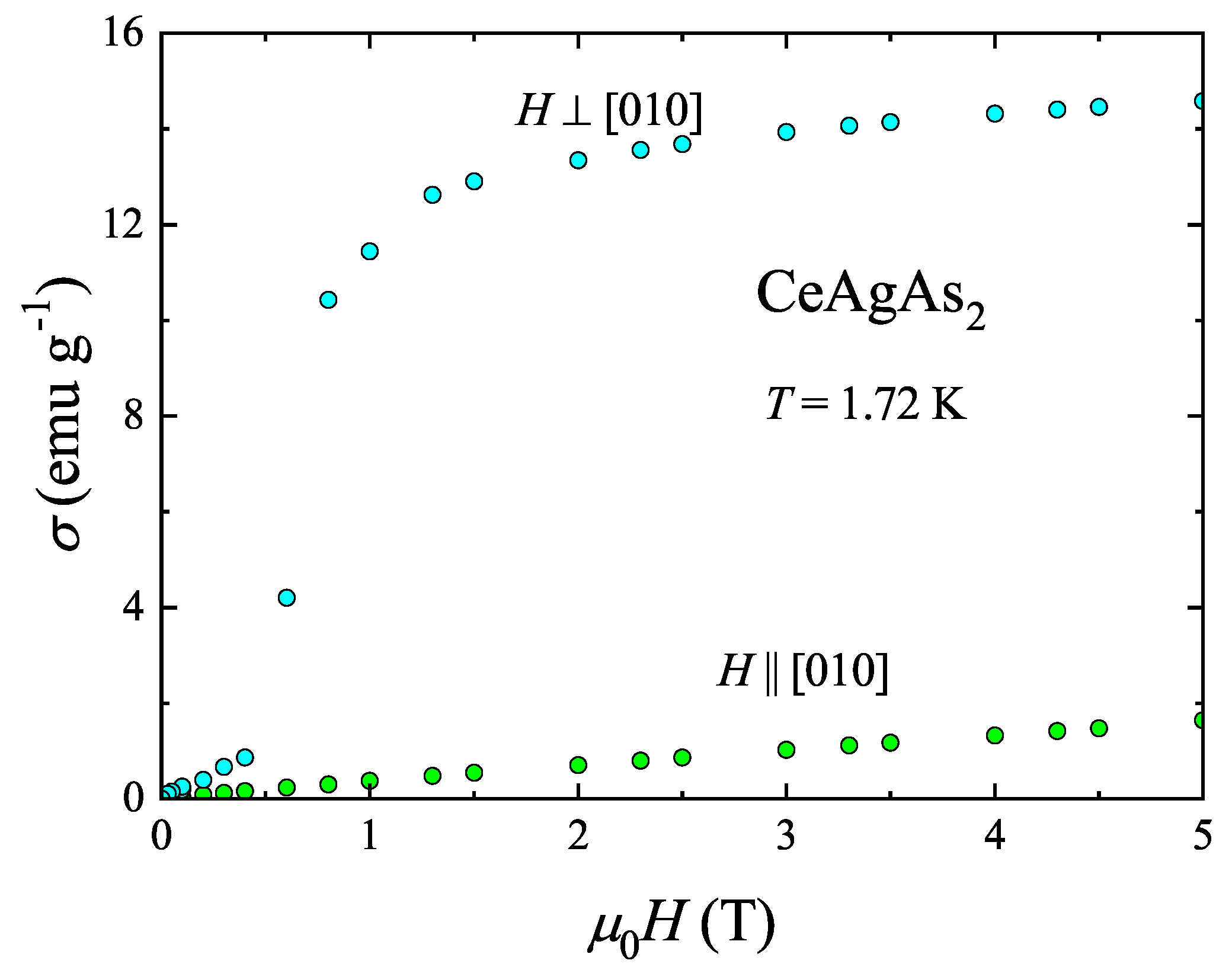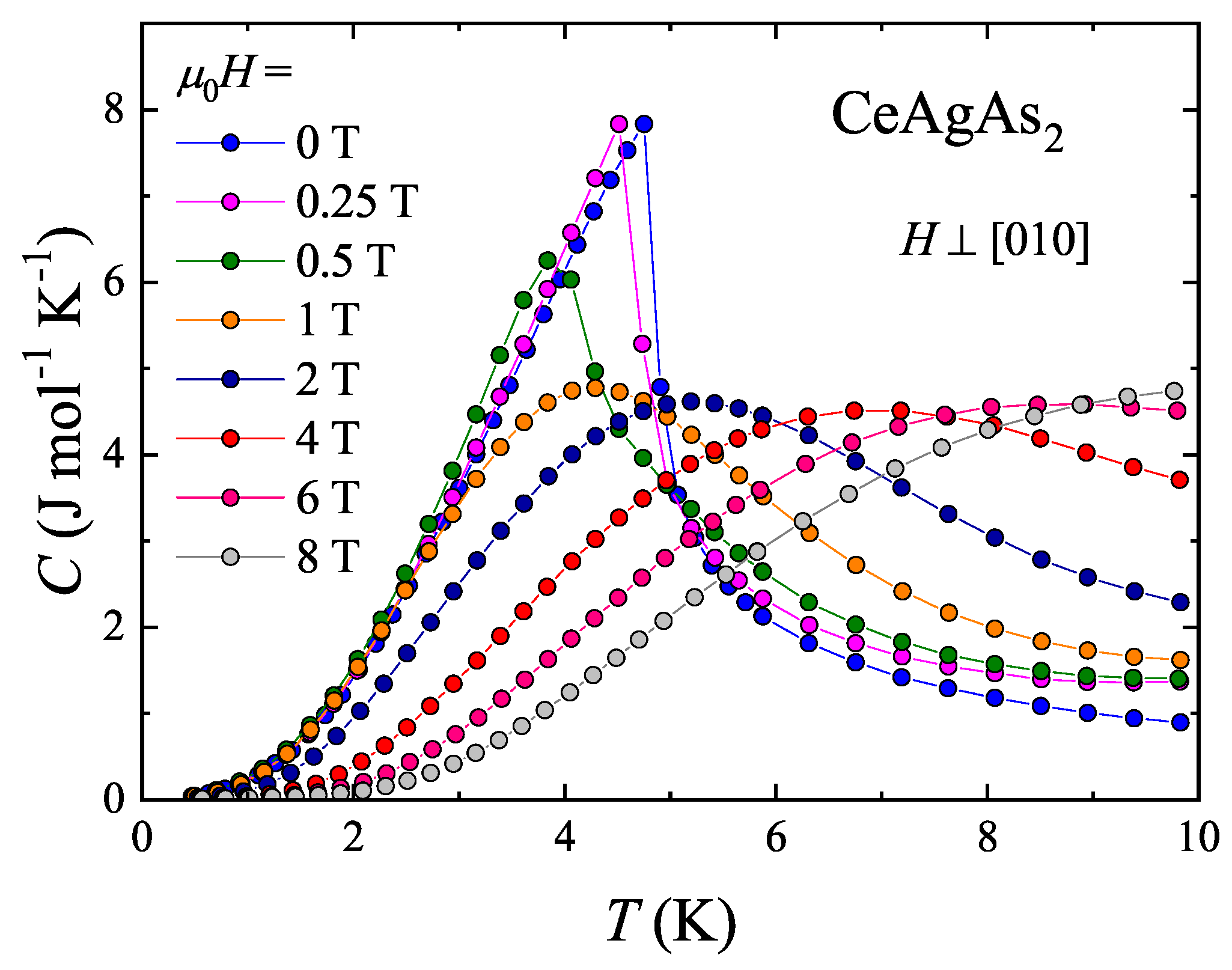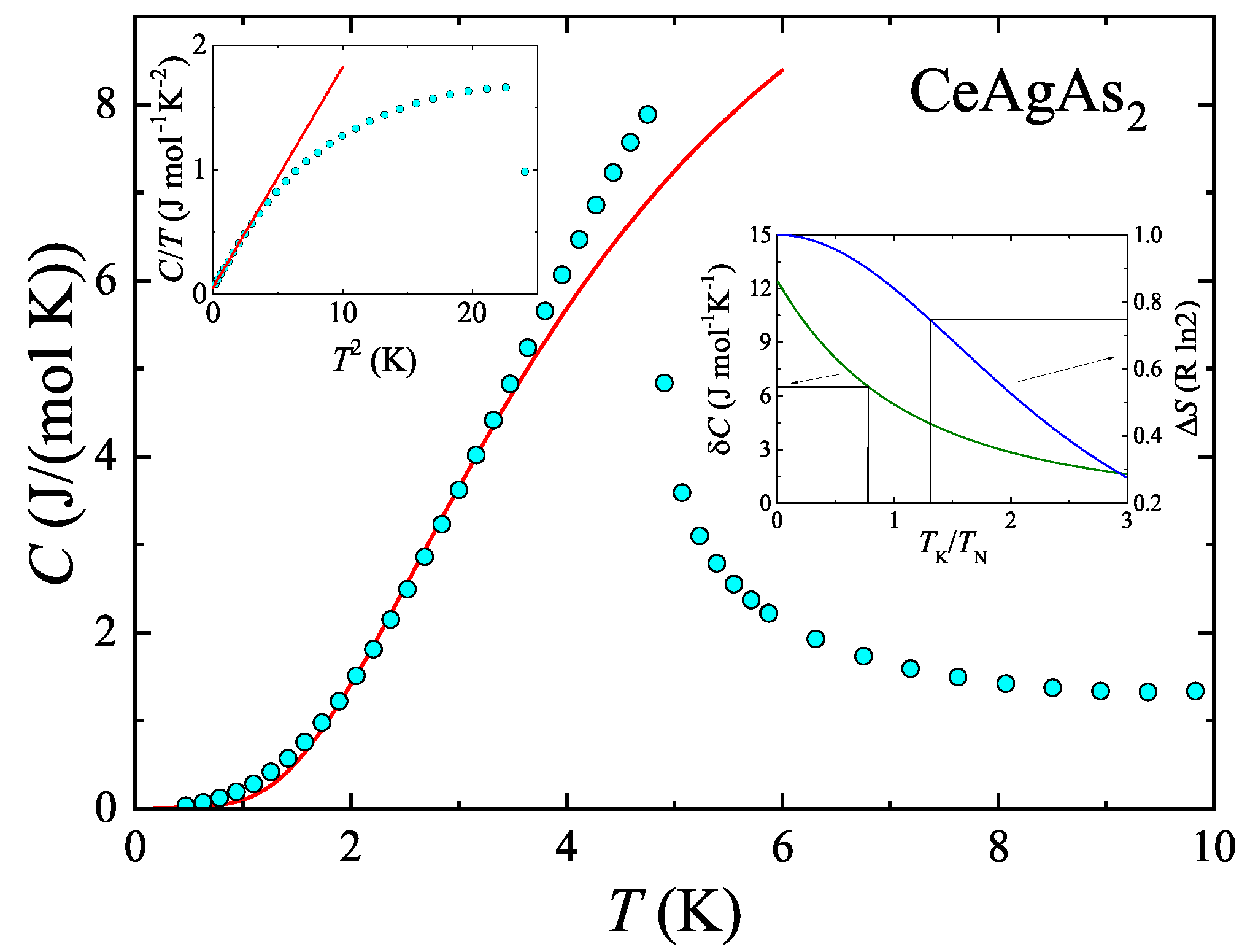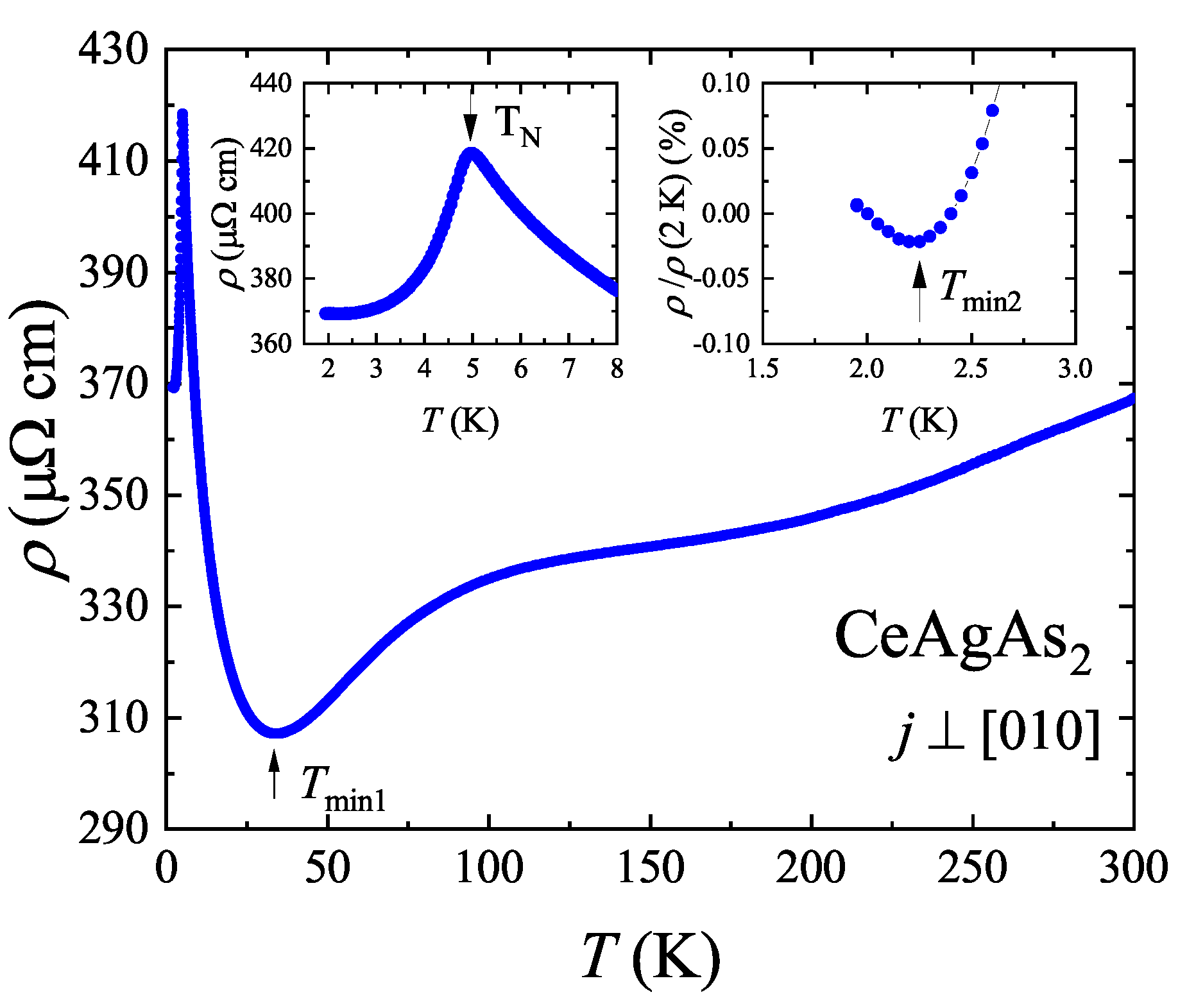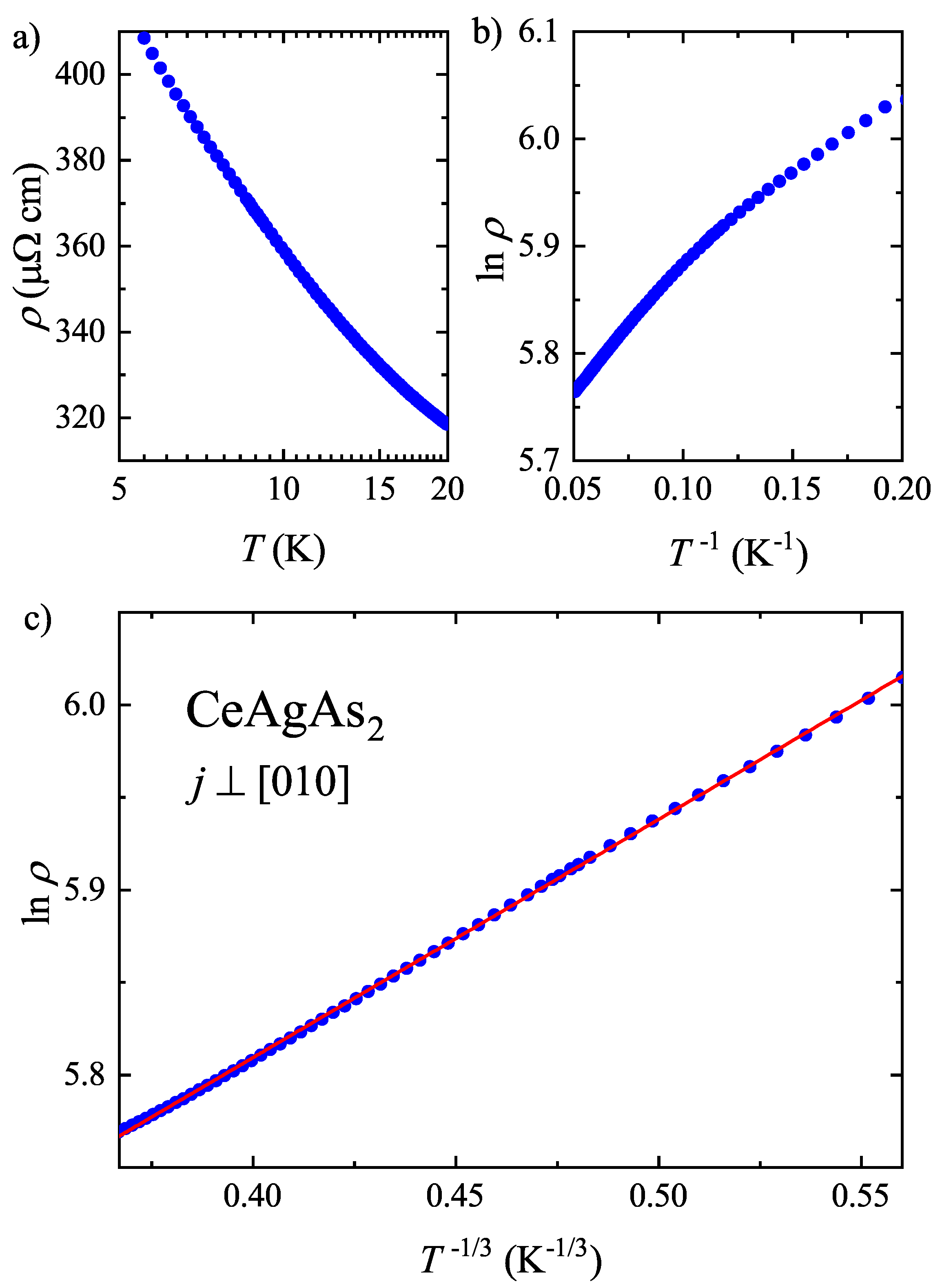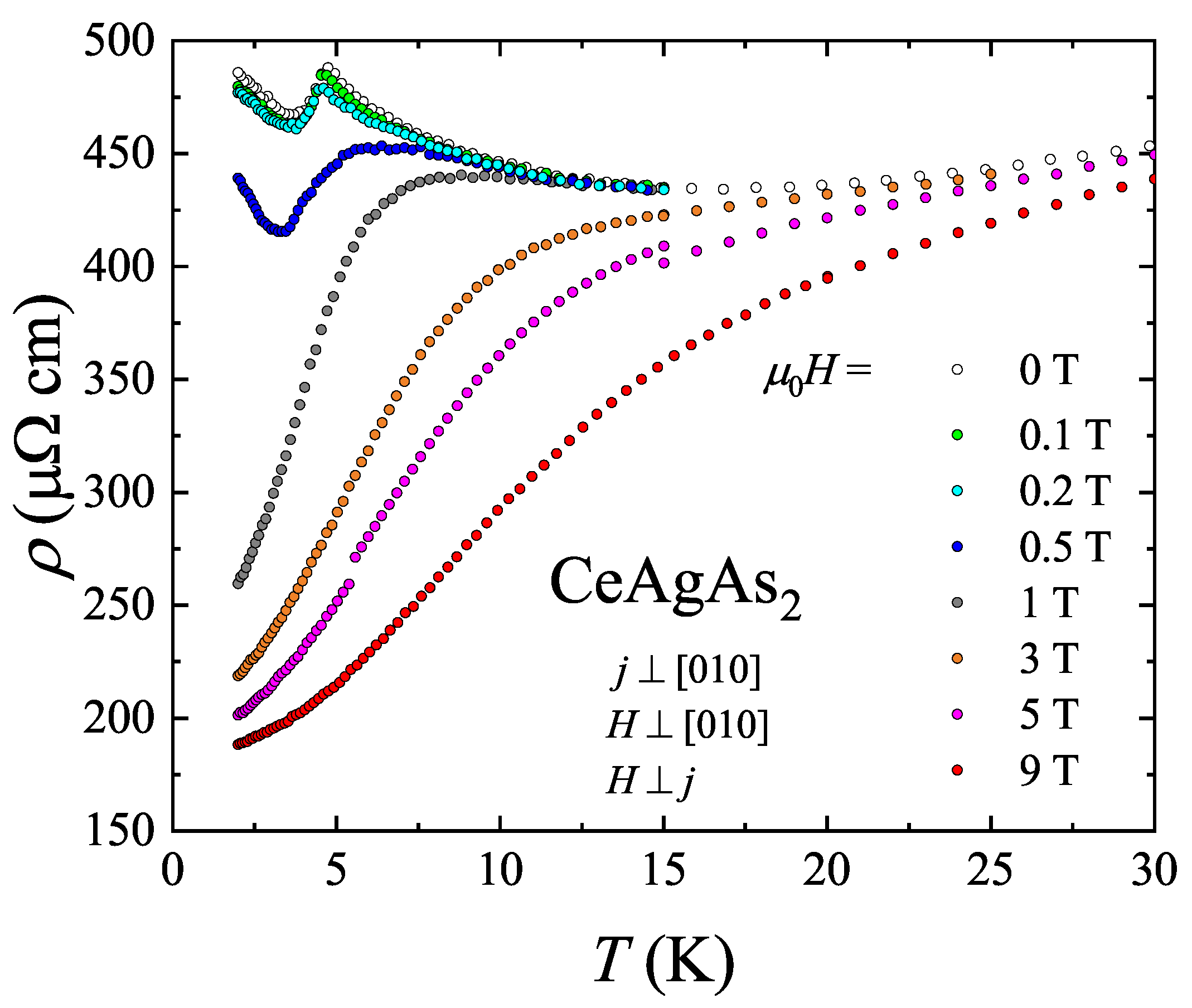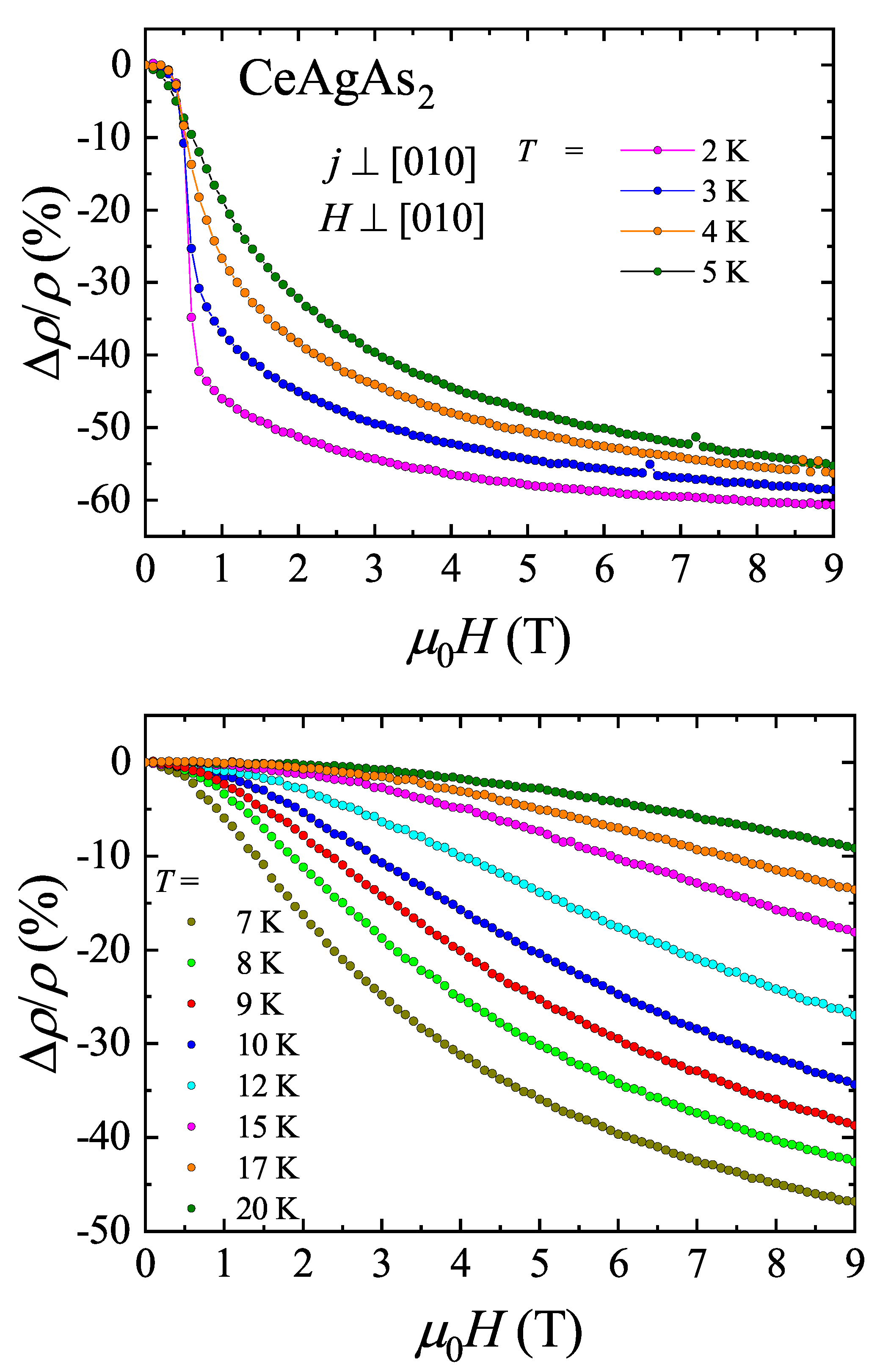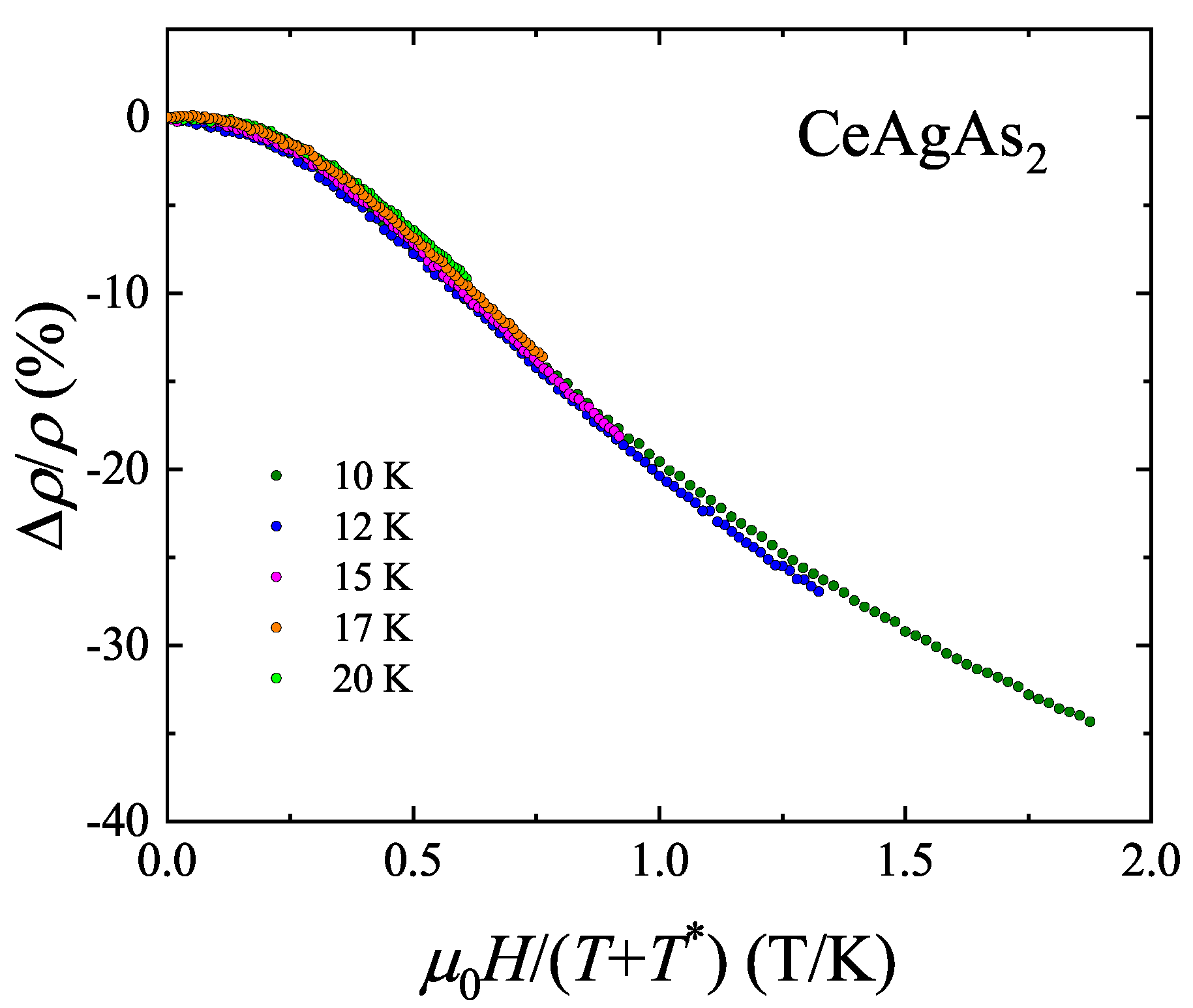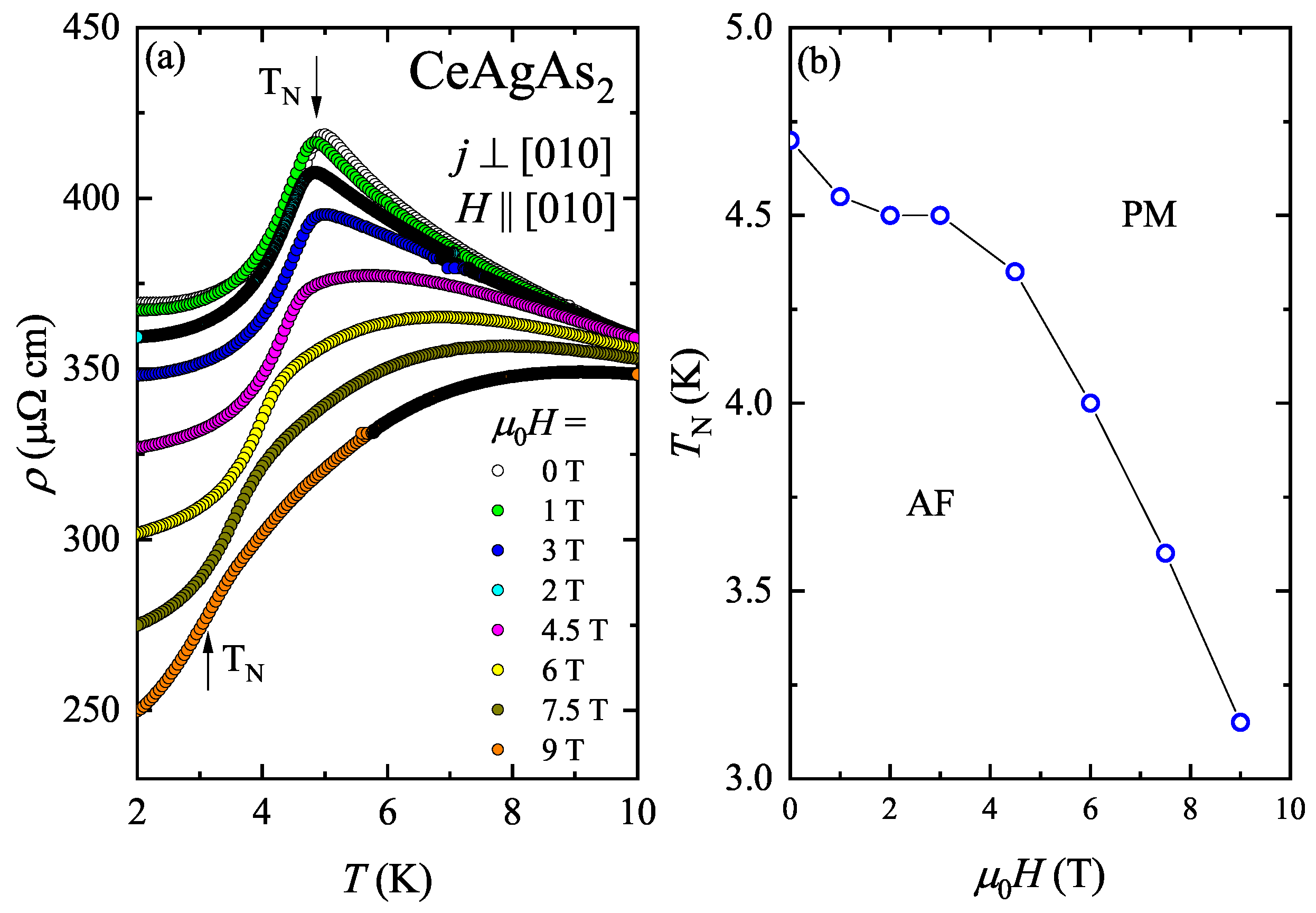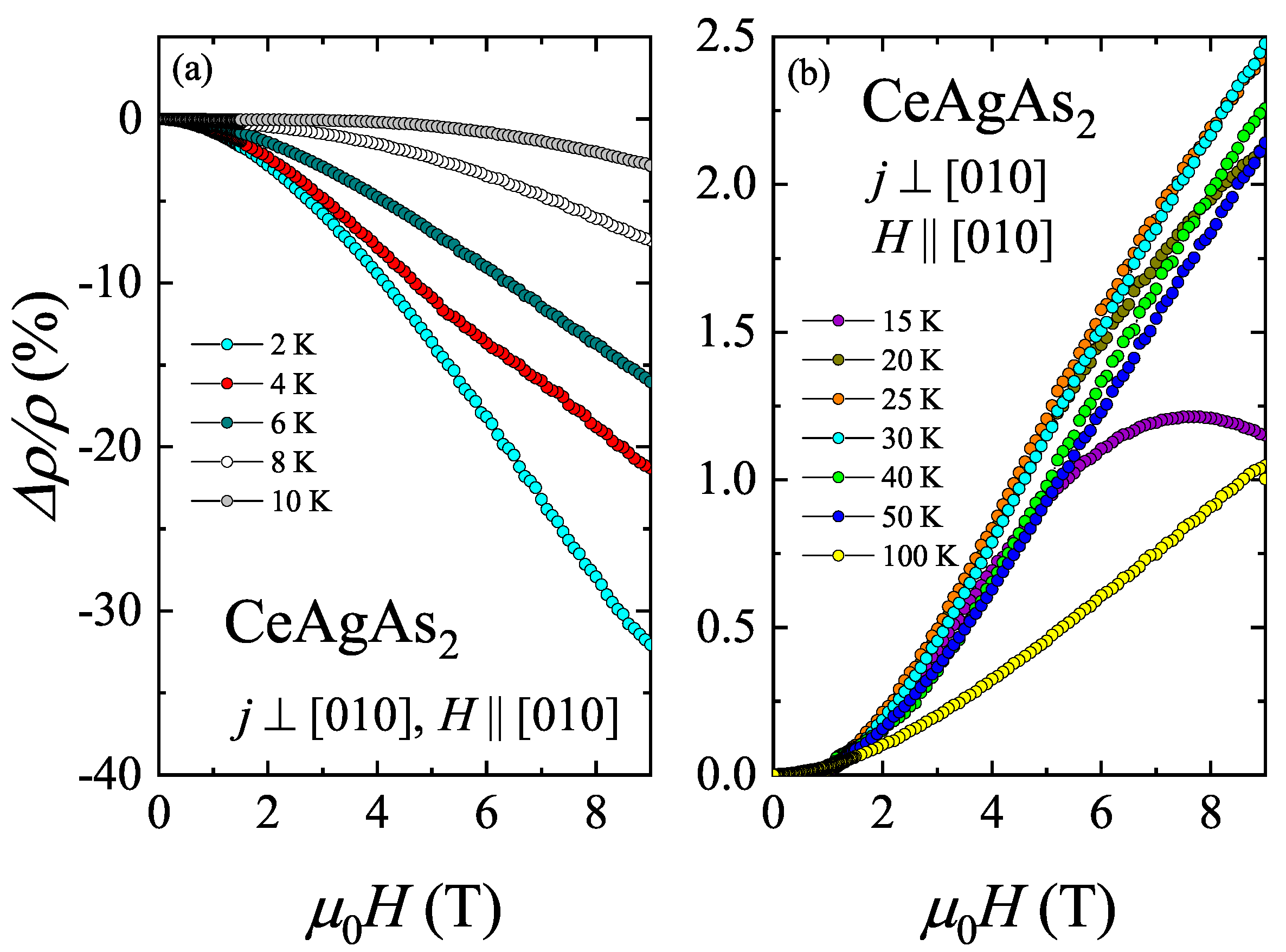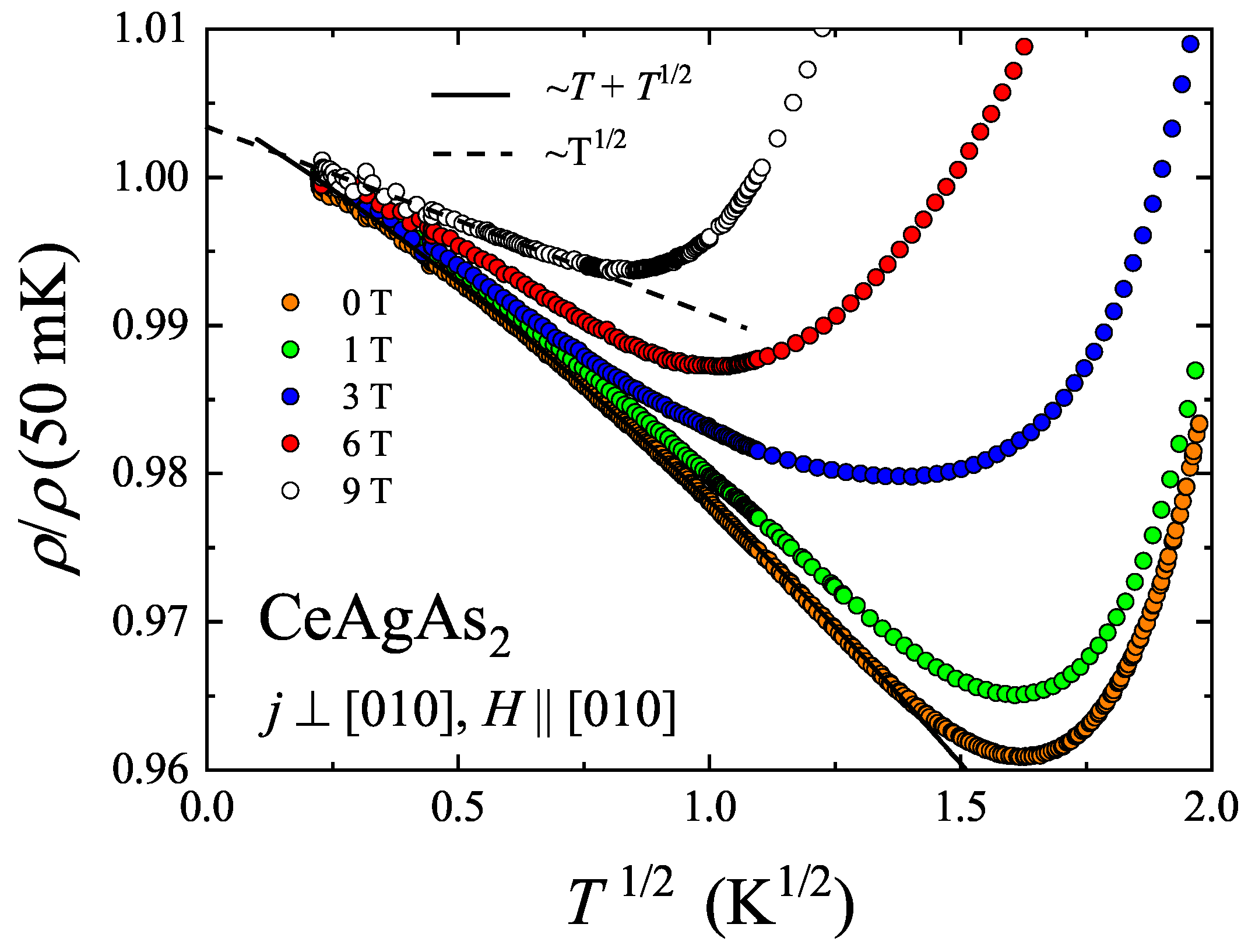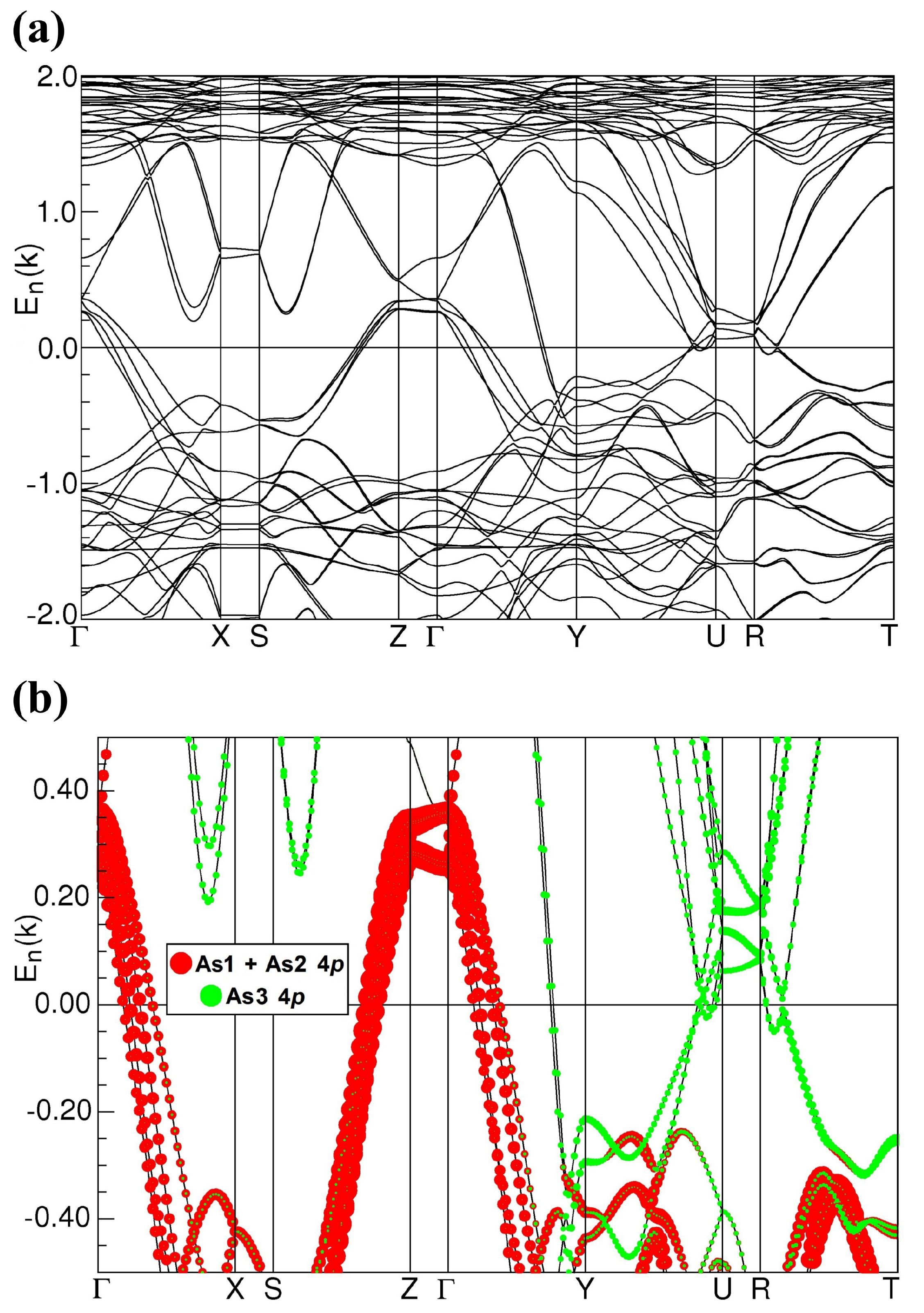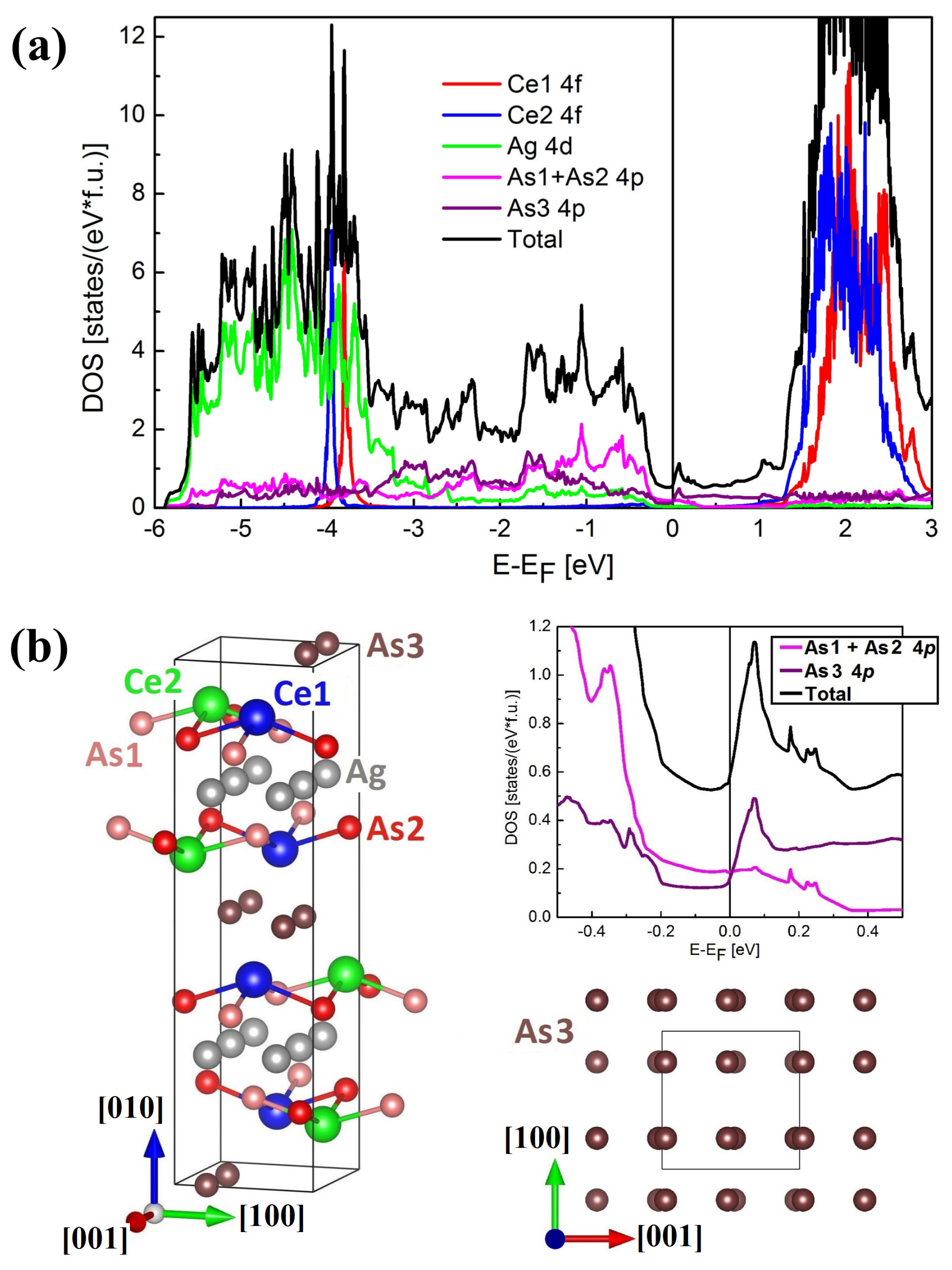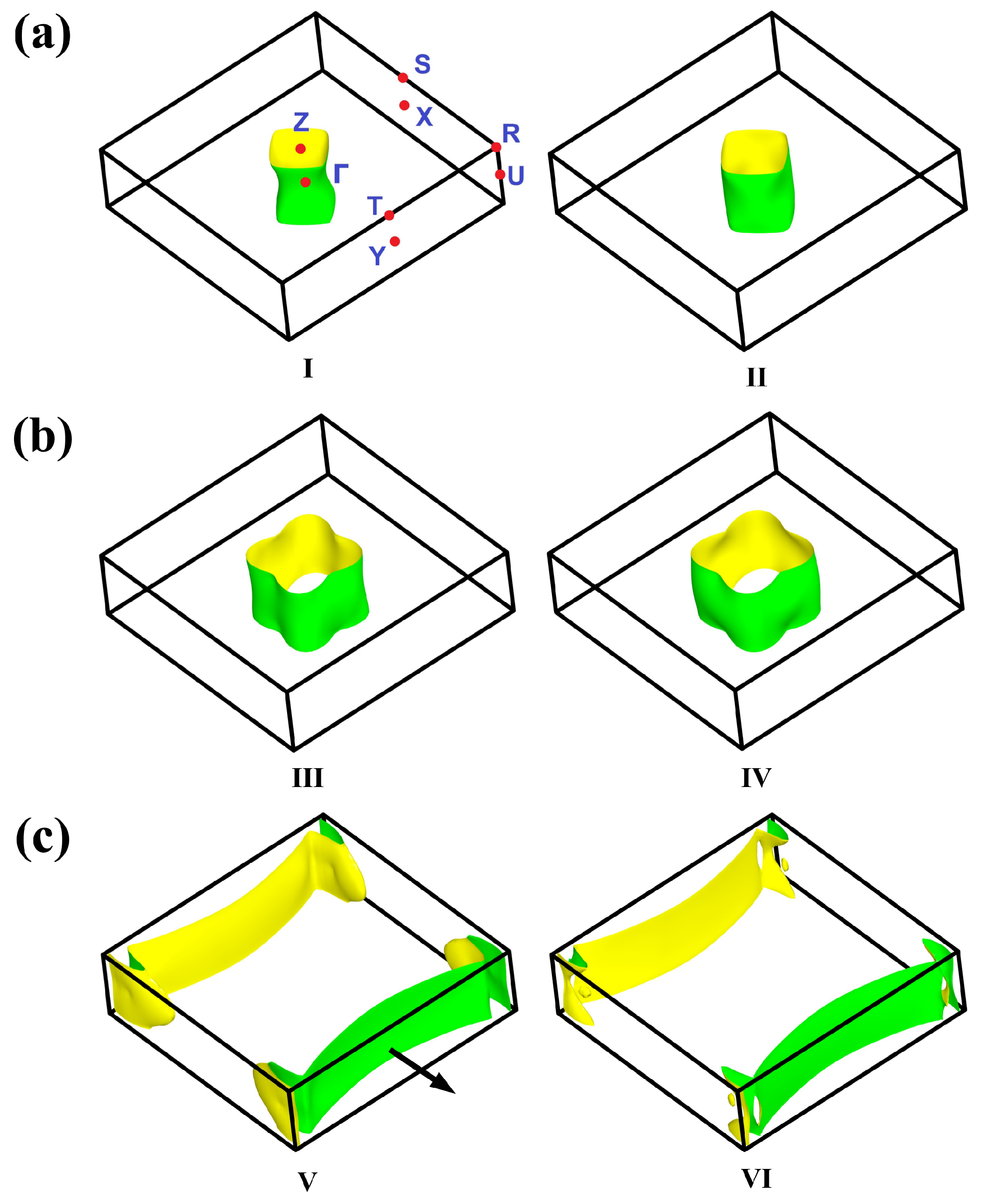2.2. Magnetic Properties
Figure 1 presents the temperature dependencies of the reciprocal molar magnetic susceptibility of CeAgAs
2,
and
, measured parallel and perpendicular to [010] direction, respectively. The compound exhibits large magnetocrystalline anisotropy and the
variation shows a wide maximum at about 70 K. At high temperatures (above 50 K and 250 K for susceptibility variation taken with
and
, respectively), both curves follow Curie–Weiss (C-W) law in the form
. The least-square fitting parameters of this formula to the experimental data obtained with
are
and
. The magnetic effective moment
is the same as that predicted within Russel–Saunders coupling scenario for a free trivalent Ce ion (2.54
). In turn, the positive sign of the paramagnetic Curie temperature
hints at importance of ferromagnetic interactions, as inferred from neutron diffraction data [
11]. Due to rather narrow range of straight-linear variation of
, the effective magnetic moment was assumed to be the same as for
, while fitting the C-W dependence. The obtained value of
is equal to −123 K. The large difference between
estimated for the two main crystallographic directions is a measure of strong magnetocrystalline anisotropy. The large absolute value of
likely results from CEF splitting of the
multiplet into three Kramer’s doublets.
The low-temperature variations of the magnetic susceptibility of CeAgAs
2 measured in a few different magnetic fields oriented within the (010) plane and in a field of 0.1 T applied along [010] are presented in
Figure 2. The susceptibility shows large magnetic anisotropy with the component taken along [010] being much smaller than that taken within the (010) plane. This result is consistent with the neutron diffraction experiment, that revealed that the magnetic moments in CeAgAs
2 are confined to the (010) plane [
11]. The
variations measured in weak fields exhibit distinct maxima, which signal the onset of long-range AFM ordering. The transition temperature defined as an inflection point on the
variation taken at 0.01 T (Ref. [
13]) amounts to 4.9 K. This value is somewhat smaller than those reported in Refs. [
9,
11] but the same as that of the lower-temperature transition in Refs. [
6,
12]. In contrast to the behavior of
, no maximum is seen in the
variation (some little effect can be attributed to small misalignment of the specimen), and in this case the susceptibility shows below
a plateau characteristic for antiferromagnets probed perpendicular to the direction of magnetic moments.
With increasing the magnetic field strength, the maximum in shifts towards lower temperatures, as may be expected for antiferromagnets. In fields stronger than 0.5 T, the maximum is no longer discernible suggesting the occurrence of the field-induced MM transition.
The MM character of CeAgAs
2 is corroborated by inspecting the field dependencies of the magnetization measured in the ordered state. The isotherms taken at 1.72 K are presented in
Figure 3. The variation measured along [010], being clearly the hard magnetic direction, is linear up to a limiting field of 5 T. In contrast, the magnetization measured with the magnetic field applied perpendicular to [010] shows a rapid increase near 0.5 T, and then tends towards saturation in stronger fields. The magnetic moment measured at 5 T has a value of 1
, in perfect agreement with the neutron diffraction data [
11].
2.3. Heat Capacity
The low-temperature dependencies of the specific heat of CeAgAs
2 measured in various external magnetic fields applied within the (010) plane are shown in
Figure 4. In zero field
exhibits a pronounced
-like anomaly at the Néel temperature
K, in concert with the magnetic data. Upon gradual increasing the magnetic field strength, this anomaly initially shifts towards lower temperatures, as expected for antiferromagnets, and in fields stronger than 0.5 T, the maximum in
broadens and moves towards higher temperatures, in a ferromagnetic-like manner. The observed behavior corroborates the MM-like phase transition anticipated from the magnetization data.
Figure 5 presents the zero-field dependence of the specific heat of CeAgAs
2. As can be inferred from the figure, below
, the
variation can be well described by the equation [
14,
15]
where the first term accounts for the electronic contribution and the second one is appropriate for excitations of AFM spin waves above a gap
in the magnon spectrum (phonon contribution was considered to be negligible at such low temperatures). The electronic part of the specific heat was estimated by linear fit of the
vs
variation at lowest temperatures (see the inset to
Figure 5) as
mJ mol
K
. The least-square fit of Equation (
1) to the experimental data with fixed
value yielded the parameters:
and
. The moderately enhanced value of
, being close to that given in Ref. [
12], manifests the importance of strong electronic correlations in the compound studied. Remarkably, the energy gap
has magnitude similar to the Néel temperature of CeAgAs
2.
In AFM Kondo lattices, specific heat jump due to magnetic ordering
is reduced compared to the value predicted within the mean-field approximation. In the framework of the
resonant model,
is related to the characteristic Kondo temperature
via the formula [
16,
17,
18]
where
, while
,
and
are first three derivatives of the digamma function. The inset to
Figure 5 shows this universal relation that implied
of about 3.8 K for the jump 6.5
, observed for CeAgAs
2.
Another way of determining
in Kondo lattices is based on the analysis of magnetic entropy released by the Néel temperature
, which can be expressed as [
19]
For CeAgAs
2 one finds
, which would imply the Kondo temperature of about 6.4 K (see the inset to
Figure 5). The so-derived values of
are larger than that given in Ref. [
12].
2.4. Magnetotransport Properties
The temperature variation of the electrical resistivity
of CeAgAs
2 was measured with electric current flowing within the crystallographic (010) plane. The
dependence presented in
Figure 6 can be divided into a few ranges. Between the room temperature and the resistivity minimum located near
= 34 K, the resistivity decreases with decreasing temperature initially in a quasi-linear manner and then forms a broad hump around 200 K. While the former temperature dependence likely originates principally from scattering of conduction electrons on phonons, the broad anomaly in
may be attributed to an interplay between CEF interactions and Kondo effect usually observed for Ce-based intermetallics [
20]. Below
the resistivity sharply increases in a manner typical of insulators or semiconductors. Remarkably, this semiconducting-like change of the resistivity is interrupted at
= 5 K, where
reaches its maximum value (see the left-hand side inset to
Figure 6). The peak position matches very well with the AFM transition temperature
derived from the magnetic susceptibility measurements. Below
the resistivity decreases again, which is mainly a result of scattering of charge carriers on magnons. Interestingly, the expected tendency towards saturation of the resistivity at temperatures much lower than
is broken near
= 2.3 K, below which a small upturn occurs (see the right-hand side inset to
Figure 6). However, as argued below, the origin of this increase is different from that of the resistivity behavior between
and
.
In order to find out what kind of scattering mechanism is responsible for the electrical transport in CeAgAs
2 before the AFM order sets in, the
data measured in the range of 5.5–20 K were analyzed in terms of three different physical scenarios. In
Figure 7a, a logarithmic temperature dependence of the resistivity is examined, characteristic of incoherent Kondo scattering that was suggested in Ref. [
12] to dominate the charge transport in CeAgAs
2 above
. Apparently, in the case of the crystal studied herein, a
behavior can hardly be identified, which indicates that the simple Kondo scenario may not be adequate. In this context, it should be noted that the magnitude of the resistivity of CeAgAs
2 increases within narrow temperature interval (between 34 and 5 K) by more than 100
cm. Such a semiconducting-like character may be ascribed to the formation of a small pseudo-gap at the Fermi energy in CeAgAs
2, as revealed in band structure calculations (see below). Typically, the resistivity can be approximated by the expression
describing thermal excitation of conduction electrons over hybridization gap
.
As can be inferred from
Figure 7b, the
dependence does not reproduce well the resistivity data of CeAgAs
2. Anticipating the presence of several active channels of the electrical conduction, such as transport involving in-gap donor or acceptor states, the resistivity of CeAgAs
2 in the same temperature range from 5.5 K to 20 K was analyzed in terms of the relation
, where
x is a parameter which defines different hopping transport regimes and
represents a characteristic material constant [
21,
22]. This type of temperature dependence of the resistivity is basically expected in insulators and semiconductors, in which conduction of electric current is realized through hopping of charge carriers between localized states. As shown in
Figure 7c, the best description of the experimental data was obtained with the parameter
x equal to
. This finding agrees very well with the results of band structure calculations, which revealed a predominant 2D character of the Fermi surface in CeAgAs
2 (see below).
Figure 8 displays the electrical resistivity of CeAgAs
2 measured within the (010) plane in external magnetic field also confined in the same plane and oriented perpendicular to the flowing current. These measurements were carried out using different single-crystal of CeAgAs
2 from the same batch. It should be noted that the resistivity of this crystal is somewhat larger, the low-temperature minimum in
is located at higher temperature and the lowest-temperature upturn is more significant compared to the data presented in
Figure 6. As can be seen in the figure, in weak magnetic fields, the electrical resistivity is hardly changed, and the main effect is small shift of the maximum due to magnetic ordering towards lower temperatures, as expected for antiferromagnets. However, in a field 0.5 T, the decrease of the resistivity is distinct and the maximum is much broader. At stronger fields, the latter feature disappears completely and the resistivity decreases significantly. The observed behavior of
results from the MM transition that occurs in
T. Further support for this interpretation comes from the inspection of the isotherms of the transverse magnetoresistance (MR) of CeAgAs
2 defined as
and measured with electrical current and magnetic field oriented as described above. The variations measured at low temperatures are gathered in the upper panel of
Figure 9. Noticeably, initially the magnetic field hardly affects the resistivity, however in a field of 0.5 T, a sudden drop of
occurs, marking the MM transition. At 2 K, the MR attains a large value of −60 % in a field of 9 T.
The lower panel of
Figure 9 presents the
data collected in the paramagnetic state. At each temperature the MR is negative and large. As displayed in
Figure 10, all the isotherms can be superimposed onto each other using the single-ion Kondo scaling relation
, derived within the Bethe–Ansatz approach [
23]. The characteristic temperature
, which ensures the best overlap of the MR curves, amounts to
K. This value is close to that given in Ref. [
12]. The negative sign of
manifests strong ferromagnetic interactions between magnetic moments within the (010) plane, as revealed by neutron diffraction measurements [
11].
To elucidate the source of the low-temperature upturn in the electrical resistivity, the resistivity measurements were performed with magnetic field oriented along the [010] axis, being hard magnetic direction. Influence of the magnetic field on the
dependencies of CeAgAs
2 measured in the vicinity of
is shown in
Figure 11a. In magnetic fields up to 3 T,
variation does not change significantly. With increasing the field strength, the peak in
shifts slightly towards lower temperatures while the magnitude of the resistivity diminishes giving rise to negative MR. Above 3 T, this sharp peak transforms into a broad maximum which moves towards higher temperatures with increasing field. The evolution of the Néel temperature, defined as a maximum in the first derivative of the resistivity
with magnetic field is shown in
Figure 11b.
Figure 12 depicts the magnetic field dependence of the MR taken with external magnetic field oriented along the [010] axis, i.e., perpendicular to the magnetic moments which are confined within the crystallographic (010) plane [
11]. Between 2 and 10 K,
is negative in the entire field range. The absolute value of
is quite significant at the lowest temperatures being equal to −32 % at 2 K and in a field of 9 T. Remarkably, at this temperature, no MM-like anomaly in
was found up to 9 T. With increasing temperature, the absolute value of the MR decreases. At T = 4 K, a small hump is seen near 6 T that can be attributed to the MM transition. This behavior is in line with the data presented in
Figure 11b. For
15 K, the MR changes sign to positive. At 15 K, the negative contribution to
can be still observed at higher fields as a decrease of the MR above 7 T. With increasing temperature, the negative contribution to
decreases. It is also worth noting that the magnitude of positive MR is much smaller than the negative contribution observed at low temperatures. The maximum positive value of the order of 2.5 % was found at 25 and 30 K, i.e., in the vicinity of
. Above
, the magnitude of
decreases. The positive MR observed at high temperatures usually result from cyclotron motion of conduction electrons in the presence of external magnetic field.
In order to further search for the origin of the low temperature upturn in the resistivity, the measurements were extended towards lower temperatures. Though performed on a different sample of CeAgAs
2, the orientations of current and magnetic field with respect to the crystallographic axes were preserved, i.e.,
and
.
Figure 13 shows the temperature variation of the resistivity normalized to its value at 50 mK (note a
scale). The resistivity goes through a minimum near
2.6 K, which is slightly higher than
found for the other sample (see above), however the magnitude and the field dependence of
of the two specimens are very similar. Between 0.1 and 2 K, no hint at any MM transition was found in accordance with the phase diagram presented in
Figure 11b. It should be noted that for both single-crystalline samples of CeAgAs
2, the resistivity attains rather high magnitude, which probably implies that elastic scattering of conduction electrons on crystal structure imperfections plays an important role in the low temperature electronic transport. Remarkably, as can be inferred form
Figure 13, the upturn in
of the sample measured in zero field can be described by the relation:
-
with the residual resistivity
= 389.4
cm, and the prefactors
= 8.03
cm K
and
= 2.27
cm K
. The so-derived residual resistivity is somewhat larger than that found for the sample considered above. The square-root-in-
T term represents interaction quantum correction or Altshuler-Aronov correction, which is a typical contribution to low temperature resistivity of disordered conductors independent on their ground state properties [
24,
25,
26]. In turn, linear-in-
T term stands for quantum correction due to scattering of conduction electrons on spin waves [
27], expected for magnetically ordered materials, being independent of the type of magnetic ordering and the system dimensionality.
As shown in
Figure 13, the observed linear-in-
T behavior gradually disappears with increasing the strength of external magnetic field. The resistivity measured in a field of 9 T can be well described below the minimum by relation containing only the square-root-in-
T contribution:
, where
= 241.9
cm and
= 3.05
cm K
. This finding is in an agreement with the behavior anticipated for magnetically ordered metallic systems, in which spin-wave mediated interaction correction to the resistivity becomes suppressed in strong magnetic fields due to damping of spin waves excitations. In turn, the Coulomb interaction correction governed mainly by singlet term and triplet term with
inherently does not depend on the magnetic field, while triplet term with
1 is cut off for fields large enough to make the Zeeman splitting energy much larger than thermal energy of conduction electrons. In such conditions the Coulomb interaction is not destroyed by magnetic field and the system exhibits positive MR.
Since the singlet and triplet terms contribute to the total quantum correction with opposite signs, one may expect that magnitude of the interaction correction does not decrease with increasing magnetic field. This same, the minimum should shift to higher temperatures. As shown in
Figure 11, in a magnetic field of 9 T the residual resistivity of CeAgAs
2 is reduced down to about 120
cm. Since the quantum corrections are correlated with the residual resistivity value, one can deduce that with decreasing the residual resistivity the coefficient
decreases when magnetic field is applied. The difference between values of
and
may reflect the presence of another contribution to the resistivity below the minimum with very similar temperature dependence as that of the interaction correction. A likely candidate is weak localization correction that appears in magnetically ordered materials when inelastic scattering rate due to electron–magnon scattering is much larger than that associated with electron–phonon interaction [
27]. In such case, contrary to non-magnetic materials, the dephasing rate
is a relevant cut-off for the quantum interference phenomena. In the literature, there were considered two limiting scenarios, i.e.,:
and
(
and
are dephasing time and energy gap in magnon spectrum, respectively). In the former case the correction to the conductivity is proportional to
for
or is given by fractional power law in the crossover regime
. In turn, the correction predicted for
is proportional to
. Remarkably, the two latter relations yield a similar square-root-in-
T dependence of low temperature resistivity, experimentally observed for CeAgAs
2.
2.5. Band Structure Calculations
The electronic band structure calculated for antiferromagnetic CeAgAs
2 (see
Figure 14), exhibits a metallic character and generally it is very similar to the band structure of the nonmagnetic reference compound LaAgAs
2 (Ref. [
10]). It does not show any Dirac-like bands, found for a few other rare-earth (RE) pnictides RETX
2 with X = Sb or Bi [
28,
29,
30,
31]. Probably it is a combination of the AFM ordering (which splits the electronic bands) with the distortion of the nets of As3 atoms from perfect squares that causes the lack of conic-like bands originating from the As 4
p electrons near the Fermi level
. One may consider that the quasi-two-dimensional (quasi-2D) band structure (along the [010] axis) reflected in a group of split and flat bands lying 0.05–0.2 eV above
along the
Z and UR lines in the Brillouin Zone (BZ) mainly governs the transport properties of CeAgAs
2.
The total density of states (DOS) (see
Figure 15) has rather a low value at
(
states eV
f.u.
, where f.u. means the formula unit), which leads to the estimated value of the Sommerfeld coefficient
mJ K
mol
. This value is close to
mJ K
mol
, determined experimentally for LaAgAs
2 [
12], while an order of magnitude smaller than the experimental value 50 mJ K
mol
determined for CeAgAs
2 (see above). The latter value of
indicates strong electron–electron correlations typical of moderate heavy-fermion behavior. The difficulty in reproducing in band calculations proper values of
is well-known shortcoming of DFT methods applied to such systems (see, e.g., Ref. [
32]). The additional Coulomb potential U is responsible for displacement of the positions of the Ce 4
f states. The narrow peaks due to the 4
f electrons, which are fairly well localized near 4 eV below
are a source of the AFM order in CeAgAs
2. It is worth noting that the two different sites of Ce atoms (labeled in
Figure 15b as Ce1 and Ce2) show some small differences in the position of the 4
f DOS peaks being about 150 meV. However, the intensities of the two peaks are almost the same. Similar location of the
states below
was observed for other magnetic Ce-based compounds [
33,
34]. Despite the metallic character of the electronic structure of CeAgAs
2, the reduction of DOS around
is significant, alike in other RETAs
phases [
10,
35,
36]. That feature can be a reason for the semiconducting-like behavior of CeAgAs
2 as well as few similar arsenides with the cis-trans distortions in As3 layers [
10,
35]. Principally, DOS at
consists of the As 4
p contributions like in other RETX
2 compounds [
28,
30,
37]. However, the 4
p contributions originating from As1 and As2 are comparable to each other and their sum is very similar to that of the As3 atomic sites at
. Meanwhile, in other RETX
compounds the contributions of the quasi-2D square nets of pnictogen atoms (without distortions) are dominating in total DOS near
. The Ag 4
d electrons contribute to total DOS in the range from −6 eV to about −3 eV below
, wherein both Ag atoms yield very similar shape of DOS, hence it is presented here as a sum.
In the band calculation performed for CeAgAs
2, an antiferromagnetic arrangement (+ - - +) of ferromagnetically ordered Ce atom layers was assumed, as determined from the neutron diffraction data [
11]. The suitable magnetic supercell contained four nonequivalent Ce positions (twice more than those in the non-magnetic unit cell) with sufficiently large initial values of magnetic moments. By minimizing the total energy of such a magnetic supercell in the self-consistent field calculation the following values of the magnetic moments were obtained: +1.0142, +1.0135 and −1.0142, −1.0135
per nonequivalent Ce site in two adjacent planes, respectively. The Ce moment of about
is in accord with the results of the magnetization measurements (see above) and the neutron diffraction experiment [
11].
As clearly apparent from
Figure 16, the three FS sheets in CeAgAs
2, possess a quasi-2D character in concert with the strong anisotropy of the physical properties of the compound. The 4-fold symmetry of the cylindrical sheets, characteristic of the tetragonal RETX
2 compounds [
39,
40] is approximately preserved (see
Figure 16a,b), despite the small orthorhombic distortion present in CeAgAs
2, and this finding supports the afore-made simplifications in the CEF analysis of the magnetic data of the compound (see above). Remarkably the two FS sheets displayed in
Figure 16c exhibit apparent breaking of the 4-fold rotational symmetry into a two-fold one (nematic-like transition). The FS sheets labeled V and VI present discontinuity in the
(
Y) direction in BZ possessing quasi-1D character, which can be explained by an existence of the trans-cis distortion of the As3 atomic nets along the [001] axis. This type of Peierls-like transition usually leads to opening energy gap in the electronic band structure along the axis of distortion. As reflected in orbital characters of the electronic bands visualized in
Figure 14b those forming FS V and FS VI sheets originate entirely from the As3 4
p states (note the green band weights along the
X and
Y lines).
